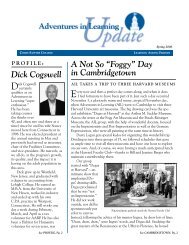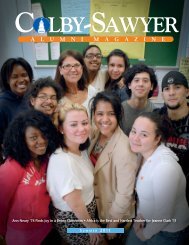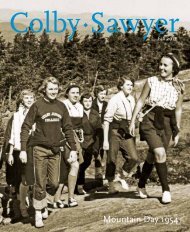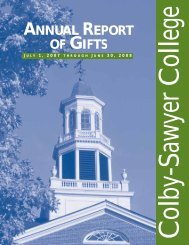A L U M N I M A G A Z I N E - Colby-Sawyer College
A L U M N I M A G A Z I N E - Colby-Sawyer College
A L U M N I M A G A Z I N E - Colby-Sawyer College
You also want an ePaper? Increase the reach of your titles
YUMPU automatically turns print PDFs into web optimized ePapers that Google loves.
Climbing a ladder to the third level of Actun Tunichil<br />
Muknal (the Cave of the Stone Sepulcher) in western<br />
Belize to view the best preserved of the 14 skeletons<br />
located there.<br />
ward embroidery stitches, and grating the heart of a cohune<br />
tree for our lunch one day. Their own work was very beautiful,<br />
from the dresses they made for themselves, to the baskets and<br />
beaded jewelry they sold to me, to a most delicious treat which<br />
they served at several meals—a crispy, slightly sweetened tortilla<br />
called a “chuqua.” Chuquas are festooned on both sides<br />
with an overall flower pattern, a decoration created not by a<br />
mold of some sort but by pressing the head of an actual flower<br />
a dozen times or so on each tortilla they made. Once again I<br />
observed how Mother Earth provides what these Mayas need to<br />
make their food taste good and look quite elegant.<br />
I clearly learned the most about how contemporary<br />
Mayas—like the Shos—are carrying on many traditional<br />
native practices during the four days I spent with them in Na<br />
Luum Ca. I absorbed much of the history of their ancestors<br />
by visiting spectacular ruins<br />
throughout Belize, like those<br />
at Caracol, Lamanai, Altun Ha,<br />
Cahal Pech and Xunantunich,<br />
where I marveled at the artistic<br />
and architectural achievements<br />
created centuries ago. I tried to<br />
imagine daily life here as it might have been between 1500 B.C.<br />
and 1500 A.D. as I climbed the massive pyramids, admired the<br />
intricate carvings on temples and altars and stelae, and envisioned<br />
spirited athletic contests on the ballcourts.<br />
What brought me closest to ancient Mayan customs, however,<br />
was my day-long visit to Actun Tunichil Muknal, a sacred<br />
site whose English translation—Cave of the Stone Sepulcher—<br />
might suggest the Indiana Jones-like adventure it afforded me.<br />
Getting to this remote site entailed a jeep ride across a river<br />
where the bridge had washed out a year ago, then a mile-long<br />
hike deep into the jungle during which we crossed the same<br />
river several times and were fed termites by our Mayan guide,<br />
Carlos (I had just one; it tasted like carrots). When we finally<br />
reached the mouth of the cave, we had to swim inside, in water<br />
over our heads, then hike and swim through water for another<br />
kilometer—often crawling through very tight spaces—until<br />
we arrived at the main chamber, where we rock-climbed to<br />
the second floor. Here we encountered a most remarkable living<br />
museum. All around us, illuminated by Carlos’ flashlight,<br />
were dozens of ceramic vessels and the skeletal remains of 14<br />
In an archway of the Inca ruins at Ollantaytambo,<br />
noted for its mortar-less stonework which has<br />
stood the test of time for thousands of years.<br />
W���������������������������������<br />
������������������������������������<br />
������������������������<br />
The skeletal remains of a 14-year old Maya girl,<br />
left in situ where the ceremonial sacrifice took<br />
place, on the third level of the cave Actun Tunichil<br />
Muknal in Belize.<br />
individuals, all in situ, where they had been left by the Mayas<br />
more than a thousand years ago. The pots, containing corn,<br />
chili peppers and cacao, served as offerings to their gods and<br />
deceased ancestors, while the copal incense discovered here<br />
would have been used during the bloodletting rituals, which<br />
accounts for the 14 skeletons. These sacrificial victims (six<br />
infants, a young child and seven adults) would have been<br />
offered to the powerful deities who were thought to reside in<br />
caves like this, including Chac the rain god, as well as the evil<br />
spirits which cause death and disease. Further underscoring<br />
the life/death duality associated with subterranean sites is the<br />
ancient Mayan belief that the spirits of their deceased ancestors<br />
made their way to these caves where, eventually, they would be<br />
reborn. Thus, entering a cave such as Actun Tunichil Muknal<br />
for an ordinary Maya would have been a very mixed blessing,<br />
providing the opportunity to<br />
honor one’s gods and ances-<br />
tors but also fraught with the<br />
possibility they might be sacrificed<br />
themselves. In an attempt<br />
to let us experience the absolute<br />
darkness an ancient Maya<br />
would have known had their torch gone out, Carlos asked us<br />
to extinguish our headlamps, hold hands, and walk through<br />
the ankle-high water for several minutes as we headed out of<br />
the cave. The blinding physical darkness surrounding us would<br />
have been compounded for the Maya by the spiritual beliefs<br />
they associated with these chambers.<br />
As these experiences with the Sho family in Na Luum Ca<br />
and my underground adventure at Actun Tunichil Mukal<br />
suggest, my own understanding of both the ancient and contemporary<br />
native peoples of Central and South America was<br />
increased exponentially through my travels. I was fortunate<br />
to meet dozens of people like the Shos and to visit dozens of<br />
ancient sites where, in often seemingly inaccessible places,<br />
these intelligent, artistic, hard-working people carved out lives<br />
that still serve as sources of astonishment to those who study<br />
them. The time I spent immersing myself in these remarkable<br />
cultures exceeded all expectations, reminding me once again<br />
that we never know where our curiosity might take us—or what<br />
treasures we might uncover—simply by being open to those<br />
unimagined opportunities which life often sends our way. ■<br />
WINTER 2010 37









